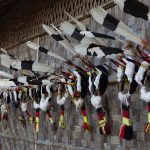It’s not uncommon that many aspects of Indian heritage and culture, such as Indian religions, mathematics, philosophy, food, languages, dance, music, and cinema, have had a favourable influence all over the globe. The IGI airport in India is one such endeavour to teach visitors from all around the world about the rich Indian culture and traditions. The Indira Gandhi International Airport in Delhi is India’s busiest airport, with up to 40 million passengers passing through it each year. One of the first things travellers notice upon arrival in India is the 240-meter-long indigenous copper and bronze art hung at the arrival passage. The copper artwork takes the form of nine mudras, or hand gestures, which are essential to Indian culture and classical dance forms, visual art, yoga and also exhibits legacy of Buddhist and Central Asian cultures. Steel skeletons with clay, resin, and plaster of Paris moulds were used to create the artwork, which was designed by Jaipur-based designer Ayush Kasliwal. The female hand shape was purposefully chosen by the designers to give the artwork a more graceful appearance.

But the real question is: why are they placed at one of the busiest places? The idea behind the display of mudras is to display the historical legacy of the Indian subcontinent and the secular spirit of India, which warmly welcomes people from around the globe. An abstract flower in the centre of the palm in the sculpture represents energy flow.It also projects the idea of connecting the world with India through the medium of yoga and spirituality. Each mudra has a unique symbolism that describes a virtue that a traveller can adopt while exploring India, a country rich in culture and spiritualism.

The mudras at the terminal are:
- Abhaya: A sign of blessing / greeting that denotes protection or reassurance. The idea conveyed here is that ‘you are safe, be fearless, I am here to shield you from all harm.”
- Varada: charity and service. The act of giving,in love and in benevolence.
- Akasha: This mudra conveys the aspiration to harness the energy of the air and the sky and guide this energy toward positive activities where it is most needed.
- Mayur: An expression of tremulous joy, just as a peacock’s fan like plume dances in the wind. This mudra symbolises flow and joy, new directions, and the oncoming of novel tidings.
- Chatura: This mudrā connotes the presence of aesthetic pleasures or sweetness in life.
- Tripataka: Denotes the application of tilaka or victory mark, on the forehead. Symbolizing journey, travel, arrival, welcome, and victory.
- Prana Mudrā: Prāńa symbolises life force. This mudra seeks to strengthen this linkage between the individual life form and the ever-throbbing life-force of the universe.
- Trishul: The trident represents threeness, trinity, and progress through energy and zeal.
- Pranayama: Symbolises good health, equilibrium, well-being, and life force.

Thus, Indian art is synonymous with its culture, traditions, and ideas. India, with its wealth of spiritual and religious knowledge, inspires travellers to be open to new possibilities, outcomes, and ideas and, most significantly, to have faith in themselves to pursue spiritual growth by walking uncharted territory. Sita’s celebrates the artistic legacy of India this World Heritage Week by bringing you interesting anecdotes from India’s rich cultural and historical legacy.
Sita, welcomes you back! Come explore India with us!





